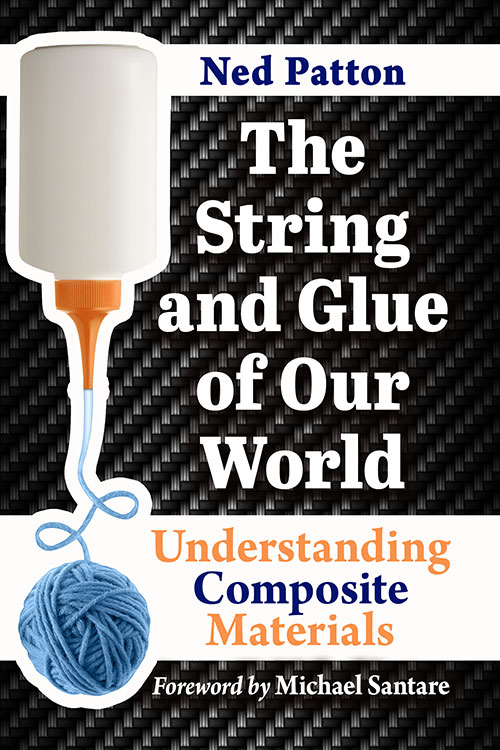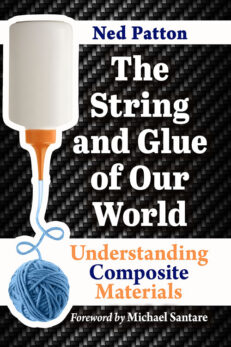The String and Glue of Our World
Understanding Composite Materials
$29.95
In stock
About the Book
This is a book about composite materials, written from the perspective of someone who has been in the industry for more than four decades and had to learn about them the hard way. Aimed at the curious citizen scientist or maker, it is written in an accessible, entertaining, and jargon-free style, introducing and explaining the how and why of composite materials.
Following a history of composites, the book discusses the periodic table of elements and why getting to know this table is so important. It then introduces strings (fibers) and glues (matrices or resins) and explains how they’re put together, how to design with them, and how to analyze what you’ve designed. The work also describes the composites business and includes a list of good schools and their involvement with industry.
About the Author(s)
Bibliographic Details
Ned Patton
Format: softcover (6 x 9)
Pages: 239
Bibliographic Info: 81 photos, notes, bibliography, index
Copyright Date: 2023
pISBN: 978-1-4766-9133-6
eISBN: 978-1-4766-4994-8
Imprint: McFarland
Table of Contents
Foreword by Michael Santare 1
Preface 5
Introduction 7
1. A Brief History of Composites 9
2. Composites and the Periodic Table of the Elements 22
Protons, Neutrons, Nucleus of an Atom, Electrons, Atomic Number, Electron Orbitals, Valence Electrons—What Are These Things? 24
Carbon 30
Silicon 33
Oxygen, Nitrogen, and Hydrogen—Elements That Make Up the Glue 37
3. Composite Fibers—the String 42
Carbon Fiber 42
Graphite 43
Glass Fiber 52
Other Fiber Types 56
Aramid Fibers 56
Other Organic Fibers 61
Boron Fiber 64
Silicon Carbide Fiber 65
4. The Glue—a.k.a. Composite Resins 67
Phenolic Resins 67
Polyester Resins 74
Vinyl Ester Resins 79
Epoxy Resins 83
Other Epoxies 86
Epoxy Curing Agents 87
Thermoplastic Resins 90
5. Making Something Out of Composites 93
String and Glue Product Forms 93
Composite Molding Processes 97
Hand Layup and Open Molding 98
Closed Molding Processes 103
Filament Winding of Composites 109
Pultrusion 111
6. Brief Introduction to the Mechanics of Composites, Ply Stacks, Unidirectional vs. Fabric 114
Mechanical Properties of Fibers 115
Mechanical Properties of Resins 117
Calculating the Mechanical Properties of a Single Ply 119
Mechanical Properties of a Ply of Fabric 121
Brief Introduction to the Effective Properties of a Laminate 123
About Allowable Stresses and Strains 127
Thicker Laminates and the Stiffness Matrix 128
7. Designing Something Using Composites 131
Where to Start—a Good Set of Requirements 131
What to Do—Makeup of a Composite Design 132
What to Do with This? Some Examples 136
Towed Vertically Directive Source—Ten Pounds in a Five-Pound Sack 137
Composite Reinforced Natural Gas Pipeline—Can’t Do This with Steel 142
NDE Calibration Blocks—How Do You Tell If It’s a Crack or Delamination or Just a Ply Drop? Or Maybe Your NDE Instrument Had a Bad Day? 146
Carbon Fiber Bicycle Frames—Go Faster, Win the Tour de France 150
8. Failure—How and Why Composites Break and How to Avoid It 154
Microscopic Composite Failure Types (Modes) and Mechanisms—How and Why 156
Fiber Failure 157
Resin or Matrix Failure 158
Fiber-Matrix Debonding 160
Macroscopic Composite Failure—It’s All About the Interfaces 161
Bonded Joint Failure 161
Bolted Connection Failures 164
Delamination and Ply Peeling Failures 164
Failure Initiation at Ply Drops and Section Thickness Changes 168
Failure Prediction—How to Avoid Disaster 168
Bulk Composite Failure Prediction 169
Fracture Mechanics and Composites 171
9. Computer Based Tools for Composites—3D Models and FEA 173
Stand Alone Tools for Composites Design and Analysis 174
ESP Composites 175
AnalySwift 175
CDS: Composite Design Software—University of Delaware 176
Digimat—e-Xstream 176
Fibersim—Siemens 176
Helius: MCT 177
CompoSIDE 177
Composites and Major Engineering Simulation Programs 178
Abaqus—Dassault Systèmes Simulia 178
Ansys Composite PrepPost 179
MSC Nastran/Patran 179
Femap/NX Nastran 180
Solidworks—Dassault Systèmes 180
10. Other Types of Composites 182
Discontinuously Reinforced Composites—Chopped Fibers and Particles 182
Plastic Matrix Discontinuous Composites 183
Metal Matrix Discontinuous Composites 185
Non-Plastic Matrix Continuous Fiber Composites 186
11. The Business of Composites 189
String Supply Business 190
Glass Fiber Business, Market, and Future 190
Carbon Fiber Business, Market, and Future 191
Aramid Fiber Business, Market, and Future 194
Polyethylene and Polyester Fiber Business, Market, and Future 197
Glue Supply Business 198
Polyester and Vinyl Ester Resin Business, Market, and Future 199
Epoxy Resin Business, Market, and Future 201
Phenolic Resin Business, Market, and Future 203
Composite Design and Fabrication Business 206
12. Jobs and Schools in Composites 209
Getting a Job in Composites Without a BS Degree in Mechanical Engineering 210
Getting a Job in Composites with a BS in Mechanical Engineering 210
Good Composites Universities 213
University of Delaware’s Center for Composite Materials 214
Northwestern University 214
MIT 215
Georgia Tech 215
Stanford 216
UC Berkeley 216
UCLA 216
UT Austin 217
Rice University 217
Penn State 218
University of Washington 218
13. Final Thoughts 219
Chapter Notes 221
Bibliography 225
Index 227
Book Reviews & Awards
- “If you are a student of materials you will love this book.”—Mark Miodownik, director, Institute of Making, University College London





